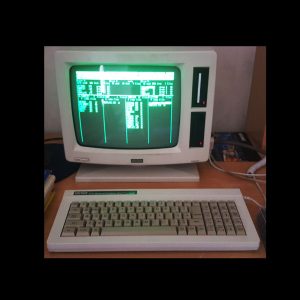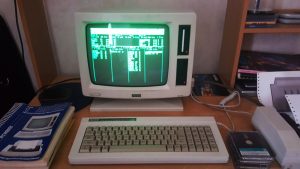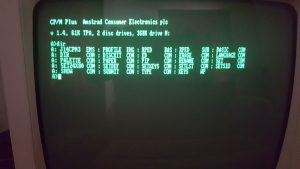
Amstrad PCW8256
Posted by musovern on Jan 30th, 2019 in Amstrad, Vintage Computers | 0 comments
The PCW 8256 was launched in September 1985, and had 256 KB of RAM and one floppy disk drive. Launched a few months later, the PCW 8512 had 512 KB of RAM and two floppy disk drives. Both systems consisted of three units: a printer; a keyboard; and a monochrome CRT monitor whose casing included the processor, memory, motherboard, one or two floppy disk drives, the power supply for all the units and the connectors for the printer and keyboard. The monitor displayed green characters on a black background. It measured 12 inches (30 cm) diagonally, and showed 32 lines of 90 characters each. The designers preferred this to the usual personal computer display of 25 80-character lines, as the larger size would be more convenient for displaying a whole letter. The monitor could also display graphics well enough for the bundled graphics program and for some games.
The floppy disk drives on these models were in the unusual 3-inch “compact floppy” format, which was selected as it had a simpler electrical interface than 3½-inch drives. In the range’s early days supplies of 3-inch floppies occasionally ran out, but by 1988 the PCW’s popularity encouraged suppliers to compete for this market. There are several techniques for transferring data from a PCW to an IBM-compatible PC, some of which also can transfer in the opposite direction, and service companies that will do the job for a fee. While all the 3-inch disks were double-sided, the PCW 256’s 3-inch drive and the PCW 8512’s upper one were single-sided, while the 8512’s lower one was double-sided and double-density. Hence there were two types of disk: single-density, which could store 180 KB of data per side, equivalent to about 70 pages of text each, and double density, which could store twice as much per side. The double-density drive could read single-density disks, but it was inadvisable to write to them using this drive. Users of single-sided drives had to flip the disks over to use the full capacity.
The dot matrix printer had a sheet feed for short documents and a tractor attachment for long reports on continuous stationery. This unit could print 90 characters per second at draft quality and 20 characters per second at higher quality, and could also produce graphics. However it had only 9 printing pins and even its higher quality did not match that of 24-pin printers. The dot matrix printer was not very robust as its chassis was made entirely of plastic. Users who needed to support higher print volumes or to produce graphics could buy a daisy-wheel printer or graph plotter from Amstrad. The daisy-wheel printer could not produce graphics.
The keyboard had 82 keys, some of which were designed for word processing, especially with the bundled Locoscript software – for example to cut, copy, and paste.Non-English characters such as Greek could be typed by holding down the ALT or EXTRA key, along with the SHIFT key if capitals were required. Other special key combinations activated caps lock, num lock and reboot.
My Amstrad PCW8256 with Books and Printer which is not working at the moment

Running CP/M v1.4 this machine will be a good candidate for a gotek drive.

Leave a Reply